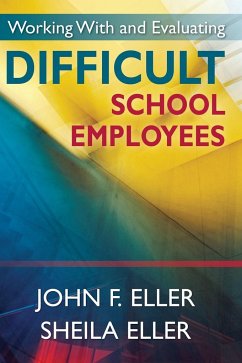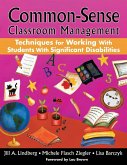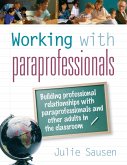- Gebundenes Buch
- Merkliste
- Auf die Merkliste
- Bewerten Bewerten
- Teilen
- Produkt teilen
- Produkterinnerung
- Produkterinnerung
Help marginal employees take positive steps to improve their performance and behavior! Managing difficult employees is one of the most challenging aspects of a school leader's job. Written by experienced administrators, this resource provides specific strategies to identify, work with, and evaluate employees who have marginal, deficient, or negative behaviors. This book includes: Sample dialogues for conducting difficult conversations Templates for putting concerns into writing and developing improvement plans Information about legal issues and ways to protect yourself Methods for working with…mehr
Andere Kunden interessierten sich auch für
![Strengthening School Counselor Advocacy and Practice for Important Populations and Difficult Topics Strengthening School Counselor Advocacy and Practice for Important Populations and Difficult Topics]() Strengthening School Counselor Advocacy and Practice for Important Populations and Difficult Topics173,99 €
Strengthening School Counselor Advocacy and Practice for Important Populations and Difficult Topics173,99 €![Strengthening School Counselor Advocacy and Practice for Important Populations and Difficult Topics Strengthening School Counselor Advocacy and Practice for Important Populations and Difficult Topics]() Strengthening School Counselor Advocacy and Practice for Important Populations and Difficult Topics227,99 €
Strengthening School Counselor Advocacy and Practice for Important Populations and Difficult Topics227,99 €![Some Thoughts About the School of the Future: A Sketch of the Solution Which Time Appears to Be Preparing for the Difficult Educational Questions of t Some Thoughts About the School of the Future: A Sketch of the Solution Which Time Appears to Be Preparing for the Difficult Educational Questions of t]() Foster Barham ZinckeSome Thoughts About the School of the Future: A Sketch of the Solution Which Time Appears to Be Preparing for the Difficult Educational Questions of t36,99 €
Foster Barham ZinckeSome Thoughts About the School of the Future: A Sketch of the Solution Which Time Appears to Be Preparing for the Difficult Educational Questions of t36,99 €![Evaluating Transition to School Programs Evaluating Transition to School Programs]() Sue DockettEvaluating Transition to School Programs198,99 €
Sue DockettEvaluating Transition to School Programs198,99 €![Common-Sense Classroom Management Techniques for Working With Students With Significant Disabilities Common-Sense Classroom Management Techniques for Working With Students With Significant Disabilities]() Jill A. LindbergCommon-Sense Classroom Management Techniques for Working With Students With Significant Disabilities40,99 €
Jill A. LindbergCommon-Sense Classroom Management Techniques for Working With Students With Significant Disabilities40,99 €![Working with Paraprofessionals Working with Paraprofessionals]() Julie SausenWorking with Paraprofessionals19,99 €
Julie SausenWorking with Paraprofessionals19,99 €![Working with Boys Working with Boys]() Andrew HamptonWorking with Boys176,99 €
Andrew HamptonWorking with Boys176,99 €-
-
-
Help marginal employees take positive steps to improve their performance and behavior! Managing difficult employees is one of the most challenging aspects of a school leader's job. Written by experienced administrators, this resource provides specific strategies to identify, work with, and evaluate employees who have marginal, deficient, or negative behaviors. This book includes: Sample dialogues for conducting difficult conversations Templates for putting concerns into writing and developing improvement plans Information about legal issues and ways to protect yourself Methods for working with teachers, secretaries and assistants, paraprofessionals, and custodial staff Steps to take when termination becomes necessary
Hinweis: Dieser Artikel kann nur an eine deutsche Lieferadresse ausgeliefert werden.
Hinweis: Dieser Artikel kann nur an eine deutsche Lieferadresse ausgeliefert werden.
Produktdetails
- Produktdetails
- Verlag: Corwin
- Seitenzahl: 136
- Erscheinungstermin: 12. Januar 2010
- Englisch
- Abmessung: 260mm x 183mm x 12mm
- Gewicht: 465g
- ISBN-13: 9781412958677
- ISBN-10: 1412958679
- Artikelnr.: 28877913
- Herstellerkennzeichnung
- Libri GmbH
- Europaallee 1
- 36244 Bad Hersfeld
- gpsr@libri.de
- Verlag: Corwin
- Seitenzahl: 136
- Erscheinungstermin: 12. Januar 2010
- Englisch
- Abmessung: 260mm x 183mm x 12mm
- Gewicht: 465g
- ISBN-13: 9781412958677
- ISBN-10: 1412958679
- Artikelnr.: 28877913
- Herstellerkennzeichnung
- Libri GmbH
- Europaallee 1
- 36244 Bad Hersfeld
- gpsr@libri.de
John Eller has had a variety of experiences in working with adults over the years he has been in education. His experiences include work educational leaders at Virginia Tech University, developing teacher leaders in a Maters program, serving as the Executive Director of Minnesota ASCD, work as a principal's training center director, a position as an assistant superintendent for curriculum, learning, and staff development, and several principal positions in a variety of settings. In addition to the work he does in training and supporting facilitators, John also does work in the areas of dealing with difficult people, building professional learning communities, employee evaluation, conferencing skills, coaching skills, strategic planning strategies, school improvement planning and implementation, differentiated instruction, leadership for differentiation, employee recruitment, selection, and induction, supervisory skills, and effective teaching strategies. He has his PhD. in Educational Leadership and Policy Studies from Loyola University-Chicago and his MS in Educational Leadership from the University of Nebraska-Omaha. John has authored books on substitute teaching, wrote The Training Video Series for the Professional School Bus Driver, The principals' Guide to Custodial Supervision contributes articles for the publication Superintendents Only. He wrote Effective Group Facilitation in Education: How to Energize Meetings and Manage Difficult Groups, and co-authored So Now You're the Superintendent, the best selling, Energizing Staff Meetings and Creative Strategies to Improve School Culture all through Corwin Press.
Preface
About the Authors
1. The Nature of Difficult/Marginal Employees: Why Don¿t These People
Listen to Reason and Improve?
Frames of Reference
Characteristics of Difficult Employees
The Response to Change
Understanding the Source of the Difficulty
Summary
2. What Skills and Tools Do I Need in Order to Take On This Situation?
Background of Employee Discipline
A Competencies-Based Approach to Thinking About Employee Problems
The Definition of Success When Working With Difficult or Deficient
Employees
Your Readiness in Dealing With a Difficult Situation or Person
The Use of Job Descriptions in Your Work With Difficult School Employees
Summary
3. Strategies for Confronting Marginal and Deficient Behaviors
Framing
Authority Voice
Summary
4. Protecting Yourself While Dealing With Difficult Employees
Presuppositions
Reflecting
Displacing Negative Energy
Additional Self-Protection Strategies
Summary
5. Strategies for Working With Difficult/Marginal Teachers
The Law and Teacher Employment
Your Master Contract or Master Agreement
Understanding Your Evaluation Criteria
The Ability to Describe Deficient or Substandard Work
Base and Surface Competancies
Deciding Whether to Move Forward to Terminate Employment or Develop a
Growth Plan
Growth Plans
Delivering a Deficiency Notice or Termination Message to a Teacher
The Entire Cycle
Summary
6. Strategies for Working with Difficult/Marginal Secretaries and Office
Handling Your Administrative Assistants
A Basic Set of Administrative Assistant/Office Employee Tasks
Base and Surface Competancies
Prioritizing Work Tasks
Planning Sessions to Establish Priorities for the Work Completion
Growth Plans
Delivering a Deficiency Notice or Termination Message to an Administrative
Assistant
Summary
7. Strategies for Working with Difficult/Marginal Paraprofessionals and
Teaching Assistants
The Nature of Teaching Assistants and Paraprofessionals
Base and Surface Competancies
Growth Plans
Delivering a Performance Concern or Termination Message to a
Paraprofessional or Teaching Assistant
An Example of a Meeting and Letter of Reprimand for a Paraprofessional
Summary
8. Strategies for Working with Difficult/Marginal Custodians
Possible Difficult Custodial Behaviors
Effective Delegation of Tasks and Assignments
Base and Surface Competancies
Growth Plans
Delivering a Performance or Skill Deficit Concern to a Custodial Employee
Summary
References
Index
About the Authors
1. The Nature of Difficult/Marginal Employees: Why Don¿t These People
Listen to Reason and Improve?
Frames of Reference
Characteristics of Difficult Employees
The Response to Change
Understanding the Source of the Difficulty
Summary
2. What Skills and Tools Do I Need in Order to Take On This Situation?
Background of Employee Discipline
A Competencies-Based Approach to Thinking About Employee Problems
The Definition of Success When Working With Difficult or Deficient
Employees
Your Readiness in Dealing With a Difficult Situation or Person
The Use of Job Descriptions in Your Work With Difficult School Employees
Summary
3. Strategies for Confronting Marginal and Deficient Behaviors
Framing
Authority Voice
Summary
4. Protecting Yourself While Dealing With Difficult Employees
Presuppositions
Reflecting
Displacing Negative Energy
Additional Self-Protection Strategies
Summary
5. Strategies for Working With Difficult/Marginal Teachers
The Law and Teacher Employment
Your Master Contract or Master Agreement
Understanding Your Evaluation Criteria
The Ability to Describe Deficient or Substandard Work
Base and Surface Competancies
Deciding Whether to Move Forward to Terminate Employment or Develop a
Growth Plan
Growth Plans
Delivering a Deficiency Notice or Termination Message to a Teacher
The Entire Cycle
Summary
6. Strategies for Working with Difficult/Marginal Secretaries and Office
Handling Your Administrative Assistants
A Basic Set of Administrative Assistant/Office Employee Tasks
Base and Surface Competancies
Prioritizing Work Tasks
Planning Sessions to Establish Priorities for the Work Completion
Growth Plans
Delivering a Deficiency Notice or Termination Message to an Administrative
Assistant
Summary
7. Strategies for Working with Difficult/Marginal Paraprofessionals and
Teaching Assistants
The Nature of Teaching Assistants and Paraprofessionals
Base and Surface Competancies
Growth Plans
Delivering a Performance Concern or Termination Message to a
Paraprofessional or Teaching Assistant
An Example of a Meeting and Letter of Reprimand for a Paraprofessional
Summary
8. Strategies for Working with Difficult/Marginal Custodians
Possible Difficult Custodial Behaviors
Effective Delegation of Tasks and Assignments
Base and Surface Competancies
Growth Plans
Delivering a Performance or Skill Deficit Concern to a Custodial Employee
Summary
References
Index
Preface
About the Authors
1. The Nature of Difficult/Marginal Employees: Why Don¿t These People
Listen to Reason and Improve?
Frames of Reference
Characteristics of Difficult Employees
The Response to Change
Understanding the Source of the Difficulty
Summary
2. What Skills and Tools Do I Need in Order to Take On This Situation?
Background of Employee Discipline
A Competencies-Based Approach to Thinking About Employee Problems
The Definition of Success When Working With Difficult or Deficient
Employees
Your Readiness in Dealing With a Difficult Situation or Person
The Use of Job Descriptions in Your Work With Difficult School Employees
Summary
3. Strategies for Confronting Marginal and Deficient Behaviors
Framing
Authority Voice
Summary
4. Protecting Yourself While Dealing With Difficult Employees
Presuppositions
Reflecting
Displacing Negative Energy
Additional Self-Protection Strategies
Summary
5. Strategies for Working With Difficult/Marginal Teachers
The Law and Teacher Employment
Your Master Contract or Master Agreement
Understanding Your Evaluation Criteria
The Ability to Describe Deficient or Substandard Work
Base and Surface Competancies
Deciding Whether to Move Forward to Terminate Employment or Develop a
Growth Plan
Growth Plans
Delivering a Deficiency Notice or Termination Message to a Teacher
The Entire Cycle
Summary
6. Strategies for Working with Difficult/Marginal Secretaries and Office
Handling Your Administrative Assistants
A Basic Set of Administrative Assistant/Office Employee Tasks
Base and Surface Competancies
Prioritizing Work Tasks
Planning Sessions to Establish Priorities for the Work Completion
Growth Plans
Delivering a Deficiency Notice or Termination Message to an Administrative
Assistant
Summary
7. Strategies for Working with Difficult/Marginal Paraprofessionals and
Teaching Assistants
The Nature of Teaching Assistants and Paraprofessionals
Base and Surface Competancies
Growth Plans
Delivering a Performance Concern or Termination Message to a
Paraprofessional or Teaching Assistant
An Example of a Meeting and Letter of Reprimand for a Paraprofessional
Summary
8. Strategies for Working with Difficult/Marginal Custodians
Possible Difficult Custodial Behaviors
Effective Delegation of Tasks and Assignments
Base and Surface Competancies
Growth Plans
Delivering a Performance or Skill Deficit Concern to a Custodial Employee
Summary
References
Index
About the Authors
1. The Nature of Difficult/Marginal Employees: Why Don¿t These People
Listen to Reason and Improve?
Frames of Reference
Characteristics of Difficult Employees
The Response to Change
Understanding the Source of the Difficulty
Summary
2. What Skills and Tools Do I Need in Order to Take On This Situation?
Background of Employee Discipline
A Competencies-Based Approach to Thinking About Employee Problems
The Definition of Success When Working With Difficult or Deficient
Employees
Your Readiness in Dealing With a Difficult Situation or Person
The Use of Job Descriptions in Your Work With Difficult School Employees
Summary
3. Strategies for Confronting Marginal and Deficient Behaviors
Framing
Authority Voice
Summary
4. Protecting Yourself While Dealing With Difficult Employees
Presuppositions
Reflecting
Displacing Negative Energy
Additional Self-Protection Strategies
Summary
5. Strategies for Working With Difficult/Marginal Teachers
The Law and Teacher Employment
Your Master Contract or Master Agreement
Understanding Your Evaluation Criteria
The Ability to Describe Deficient or Substandard Work
Base and Surface Competancies
Deciding Whether to Move Forward to Terminate Employment or Develop a
Growth Plan
Growth Plans
Delivering a Deficiency Notice or Termination Message to a Teacher
The Entire Cycle
Summary
6. Strategies for Working with Difficult/Marginal Secretaries and Office
Handling Your Administrative Assistants
A Basic Set of Administrative Assistant/Office Employee Tasks
Base and Surface Competancies
Prioritizing Work Tasks
Planning Sessions to Establish Priorities for the Work Completion
Growth Plans
Delivering a Deficiency Notice or Termination Message to an Administrative
Assistant
Summary
7. Strategies for Working with Difficult/Marginal Paraprofessionals and
Teaching Assistants
The Nature of Teaching Assistants and Paraprofessionals
Base and Surface Competancies
Growth Plans
Delivering a Performance Concern or Termination Message to a
Paraprofessional or Teaching Assistant
An Example of a Meeting and Letter of Reprimand for a Paraprofessional
Summary
8. Strategies for Working with Difficult/Marginal Custodians
Possible Difficult Custodial Behaviors
Effective Delegation of Tasks and Assignments
Base and Surface Competancies
Growth Plans
Delivering a Performance or Skill Deficit Concern to a Custodial Employee
Summary
References
Index








